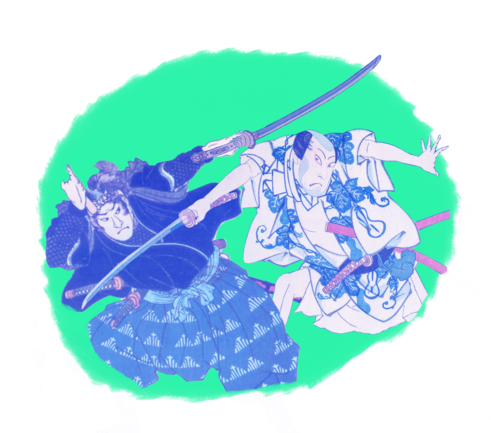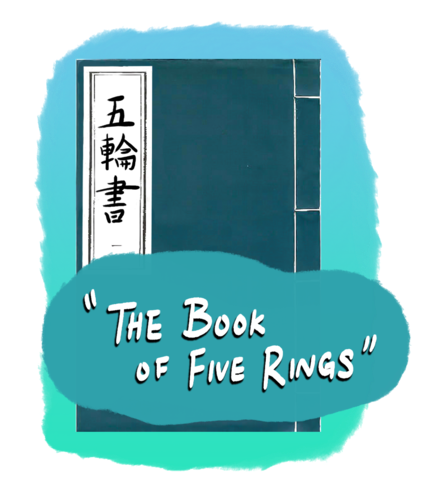
lesson 6 - the greatest samurai
Hello! And welcome to week 6 of Puppet University. I’m your TA, writer and researcher Kari Koeppel, here to dive deeper into The Professor’s lesson of the week.
I can’t tell if this is an insult or a compliment? But oh my god, he totally was. Fun fact: in 1752 the calendar shifted 10 days when Great Britain joined other European countries on the Gregorian calendar, so while Newton would’ve said his birthday was December 25, today we recognize it as January 4. No matter which way ya slice it, though, he’s a Capricorn.
And now on to Miyamoto Musashi, a man whose signature style of sleeping in and being late to everything sounds a lot like my vibe in high school.
Miyamoto Musashi (1584–1645) lived at a turning point in the history of Japan — at the end of the period of feudal wars, when Japanese society was beginning to stabilize. The fifteenth and sixteenth centuries were the most turbulent period in Japanese history, as military warlords clashed violently and frequently in attempts to increase their own power and territory. Musashi appeared on the scene in the aftermath of a century of civil war between numerous feudal domains, known as the Sengoku Period (about 1467–1568) which is typically translated as the Warring States Period. The lack of centralized power during this period marked the final years of Japan's medieval period (1185-1600) just prior to the reunification of Japan and the establishment of order and peace under the Tokugawa shoguns (1600-1868).
Musashi participated in these historic moments of transition. In 1600, he was one of 160,000 warriors who took part in the Battle of Sekigahara, which first unified Japan under the rule of the Tokugawa shoguns. Musashi, then sixteen and in the midst of his days of wandering, fought on the losing side of the battle, because the lord to whom Musashi’s family had served for a long time, was allied with them. Despite this, he survived the battle and continued wandering and fighting, going on to carve a sword out of a wooden oar on his way to battle on an island.

After the battle of Sekigahara, history loses track of Musashi for four years, before he resurfaces at age 20. For the next decade, Musashi continued to travel and duel as a means of training, fighting nearly sixty times in those years — an average of one duel every two months.
In those duels, Musashi typically armed himself with two swords, a style of fighting on which he would later base his Gorin No Sho philosophy. He would often pair a jitte, a weapon made of metal and equipped with hooks that could block a sword blow, with either the typical metal sword you’d imagine, or with a wooden sword. Yes, a wooden sword — the wooden oar carved into a sword (whose song brought a tear to my eye) was not an innovation specific to that instance. The common wooden sword of that time period was called a bokuto, and it’s still used in sword-related martial arts (like kendo) today.
By the way, if you were curious about Musashi’s unique hairdo in the episode: There was great meaning in a samurai’s hair, which was typically pulled back into a topknot called a "chomage." For battle, samurai shaved the tops of their heads and wore their hair straight on the sides, reducing the heat under their helmets.
It was after the Great Wooden Oar Duel of 1612 (as I’m calling it) that Musashi put an end to this period of duels. But, as much as it makes a grand finale, career-wise, he’d go on to fight in the battles of Osaka in 1614 and 1615. First, in the Siege of Osaka Castle in 1614, Tokugawa troops attacked its enemies from the Battle of Sekigahara 14 years previous, the Toyotomi family, as it was rumored they were planning to rebel and destroy the relative peace built up in the Tokugawa shogunate. In 1600, Musashi had fought on the losing Toyotomi side; while it’s unconfirmed which side he fought on in 1614, and many scholars believe he’d remain loyal to the Toyomis, others think it’s unlikely he’d side with near-certain loss, and that he likely was on the Tokugawa side this time around. This battle ended in a truce, with the moats of Osaka Castle filled in (and thus their defenses weakened). But a year later, after the Toyotomis dug out their moat and began to rebuild their defenses, the Tokugawa defeated them once and for all, and captured Osaka Castle (which I’ve been to, btw! OK sorry, that’s just bragging). This final victory solidified Tokugawa rule, and many historians use this date to signify the beginning of the Tokugawa era (1615-1868), a 250-year period of peace and order that would see the rise of commercial development, a merchant class, and a new modern, urban culture.
With a unified, peaceful society, samurai were not in need as they once had been. Gradually, over time, fewer men trained as samurai, instead going into the newly expanded fields of trade or bureaucracy.
So maybe, then, part of the reason for Musashi’s relative retirement also hinged on a decreased need for his work. But it’s true he adopted two sons, and dedicated himself to passing on his knowledge to them. It’s thought that one reason he adopted them was so that his family name would have some lineage in a feudal lord's system; this could be why he adopted two sons, and placed them with two different lords. The first, Mikinosuke, served the lord of Himeji Castle. Years into his service, while Mikinosuke was away in Edo, the lord died. Before returning to Himeji Castle, Mikinosuke stopped to visit Musashi, in order to say goodbye; it was traditional that a samurai follow his lord into death, a ritual suicide called seppuku that was thought of as highly honorable at the time. Thankfully, Musashi’s other adopted son, Iori, fared much better. The same year that his adopted brother died, Iori became vassal to the lord of Akashi. He held onto the position for the rest of his life (which was long).
Moving on to Musashi’s artistic period, I have to admit: What Garrick said about shrikes was news as hell to me. Through my research, I’d learned that Musashi’s style of art was called suiboku-ga, or monochrome ink painting, which was known for its power, directness, and the minimal use of brushstrokes. I knew that the style’s minimalism tied it to Buddhism, and was often practiced by Zen monks. And I knew that some of Musashi’s best-known works are paintings of birds, such as Koboku meikakuzu (“Shrike Perched in a Dead Tree”) and Rozanzu (“Wild Geese Among Reeds”). But dawg, I did NOT know that the nickname for shrikes is “butcherbirds,” due to their absolutely brutal style of killing. Garrick was right: they drop their prey from up high, impaling them on something sharp below. But before that, they break their necks, either with their beaks or by vigorously shaking them, or some combination therein. Despite being only about 9 inches, shrikes’ hunting strategy has often been compared to that of much larger birds of prey, like eagles or falcons. But shrikes, with less strength to put up with a struggle from their prey, must kill even faster. VERY CHILL. Oh, and their prey? Could be as small as a grasshopper, but could be as large as a small bird it might consider a peer (if that’s a thing birds do), like a cardinal. Chill x2.
One last thing. As you were watching the episode, you might’ve wondered how we had such a detailed play by play of some of Musashi’s most famous battles. The answer? Well, from Musashi himself. In the Gorin no sho ("Book of Five Rings"), which he wrote in the last few years of his life, Musashi not only shared his fighting strategies, but also an account of his life, sharing how he came to this philosophy. Check it out!



